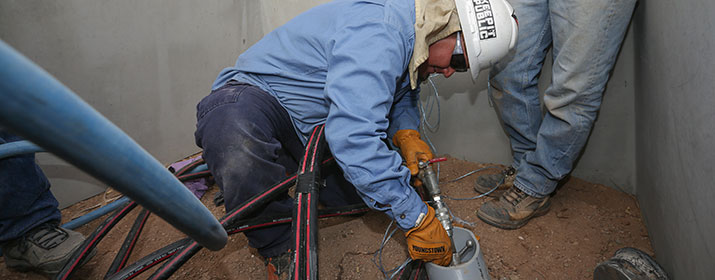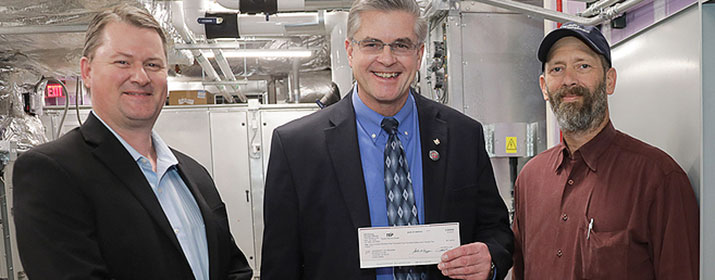
Why doesn’t TEP bury all of our power lines underground?
It’s a reasonable question, often raised after a storm or a vehicle accident results in downed power lines.
The short answer is that it’s more expensive – much more, for higher-voltage lines – and doesn’t really improve reliability. While underground lines are protected against certain types of damage, they’re more vulnerable in other ways that can lead to longer outages.
Here are five things you might be surprised to learn about underground lines:
We have lots of lines underground. Of the nearly 8,000 miles of lower-voltage distribution lines that deliver electricity to local homes and businesses, more than half – about 4,800 miles – are below ground. In most cases, the additional cost of underground installation was paid by developers or property owners to avoid increasing the costs passed along in rates to all TEP customers.
One caveat: We don’t install transmission lines underground. All 2,200 miles of our higher-voltage lines are overhead because building them underground can dramatically increase costs.
Burying power lines is expensive. It can cost significantly more to install facilities underground, and that premium is even greater for higher-voltage projects.
In part, that’s because transmission lines conduct energy flow at higher amperages than distribution cables. Since underground lines can’t release heat the way overhead lines can, that excess heat must be managed to avoid overloads. This requires the use of higher-cost conductors and other insulating infrastructure. Higher costs also typically reflect greater civil engineering expenses, additional ground disturbance and additional labor.
Considering all these factors, installing lines underground can more than double the cost of a distribution project and might increase the cost of a transmission line project by 10-20 times. Our latest study of TEP’s proposed Midtown Reliability Project, for example, indicates that overhead construction of this 138-kilovolt (kV) line would cost approximately $1.2 million per mile. Underground construction, though, would cost between $15.2 million and $26.7 million per mile. Both estimates reflect current costs and exclude the cost of necessary land rights.
Because our costs are passed along to customers, TEP avoids unnecessary expenditures to help keep our rates as affordable as possible. Customers who would like lines installed below ground for aesthetic reasons can create a utility improvement district, authorized under state law, to pay the additional costs over time. The extremely high cost of installing high-voltage lines below ground makes this option less feasible for transmission line projects.
They’re still susceptible to storms. Underground lines are certainly more protected from lightning, high winds and falling tree limbs. But they can still be impacted by storms and are particularly susceptible to flooding. Even the best cable insulation materials break down over time, allowing moisture to enter into the wires and cause shorts.
Studies of the reliability impact of “undergrounding” lines have produced mixed results. While overhead lines can be impacted by storms, repairs to underground outages are often more complex, costly and time-consuming.
That’s why TEP has instead focused on reinforcing our overhead system. We’ve accelerated our campaign to replace wood poles with steel poles, which are rarely damaged by storms. Thanks to these and other efforts, our service reliability ranks among the highest in the country.
Installing underground lines is a complex undertaking. Most of the areas where utility upgrades are needed are densely developed urban neighborhoods. Burying lines in these areas often means digging up streets and managing traffic snarls.
In most well-developed areas, there’s a maze of infrastructure underground already, from water and sewer pipes to fiber optic lines. This makes it tricky and complicated to install more utilities. Not all utilities can share the same trench, so some other utilities might have to be moved to accommodate an underground power line, causing even more disturbance and cost.
Repairs can extend outages. While TEP’s crews can easily see and repair damage to our overhead facilities, it’s much harder to pinpoint the point of failure for an underground line.
In the case of higher-voltage lines, repairs are more involved and often require specialized equipment and training that most utilities lack. Manufacturers of higher-voltage conductors typically perform much of the repair work for such lines, which can significantly extend outage response times.
Decisions about whether to install lines overhead or underground have to be made thoughtfully, said Mike Nitido, Director of Transmission and Distribution Planning and Business Operations. That’s particularly true, he noted, given that TEP’s most recent 5-year capital budget forecast anticipates investing $3.45 billion through 2028 on new generation, transmission and distribution system assets that will be needed to maintain safe, reliable service.
“Our goal is to provide safe, reliable and increasingly clean power, while also ensuring it remains affordable,” he said. “It requires a constant balance.”






